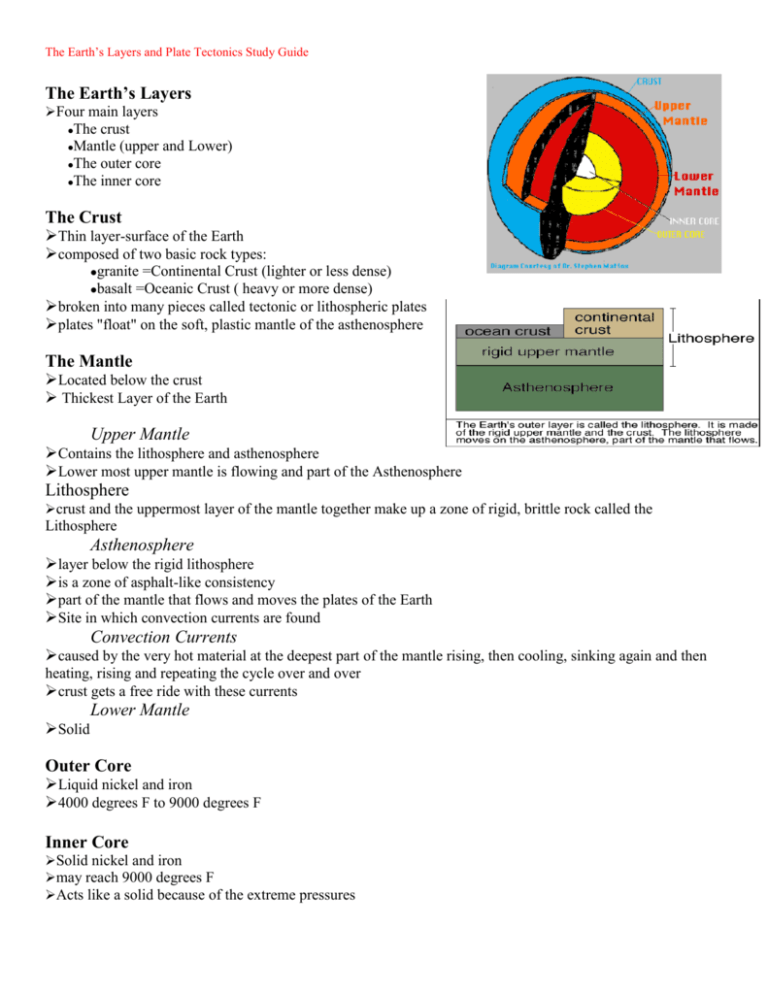The Earth`s Layers and Plate Tectonics
advertisement

The Earth’s Layers and Plate Tectonics Study Guide The Earth’s Layers Four main layers The crust Mantle (upper and Lower) The outer core The inner core The Crust Thin layer-surface of the Earth composed of two basic rock types: granite =Continental Crust (lighter or less dense) basalt =Oceanic Crust ( heavy or more dense) broken into many pieces called tectonic or lithospheric plates plates "float" on the soft, plastic mantle of the asthenosphere The Mantle Located below the crust Thickest Layer of the Earth Upper Mantle Contains the lithosphere and asthenosphere Lower most upper mantle is flowing and part of the Asthenosphere Lithosphere crust and the uppermost layer of the mantle together make up a zone of rigid, brittle rock called the Lithosphere Asthenosphere layer below the rigid lithosphere is a zone of asphalt-like consistency part of the mantle that flows and moves the plates of the Earth Site in which convection currents are found Convection Currents caused by the very hot material at the deepest part of the mantle rising, then cooling, sinking again and then heating, rising and repeating the cycle over and over crust gets a free ride with these currents Lower Mantle Solid Outer Core Liquid nickel and iron 4000 degrees F to 9000 degrees F Inner Core Solid nickel and iron may reach 9000 degrees F Acts like a solid because of the extreme pressures The Earth’s Layers and Plate Tectonics Study Guide Plate tectonics The Earth's crust is broken into many pieces called plates 12 main plates on the Earth's surface Continental Drift 1912 Alfred Wegener, German meteorologist, introduced the Continental Drift Theory that states the continents have moved and are still moving today. Support for Continental Drift Theory Continents seemed to fit together like puzzle pieces He found similar fossils on continents that are thousands of miles away from each other •similar sequence of rocks at numerous locations •plant fossils found in Antarctica which suggested that Antarctica was once a warmer continent • • Pangaea 250 million years ago the Earth's seven continents were all grouped together into a super continent Problems with Wegner’s Theory No one believed his theory because he had no way to explain how the continents moved Plate Boundaries plate boundary : where two plates come together 3 kinds of plate boundaries Convergent boundary Convergent boundary –where two plates come together. Subduction-when one plate goes under the other. The more dense plate sinks and the less dense plate floats. Divergent boundary Divergent boundary -where new crust is generated as the plates pull away from each other. Mid-Atlantic Ridge splits nearly the entire Atlantic Ocean north to south Probably the best-known and most-studied example of a divergent-plate boundary. Sea-floor Spreading-as the magma rises the older sea floor spreads apart to make room for the new sea floor Harry Hess-1960-proved Alfred Wegner’s Theory. Proposed that hot, less dense material rises toward the Earth’s crust at the mid-ocean ranges Transform boundary Transform boundary -where crust is neither produced nor destroyed as the plates slide horizontally past each other.








